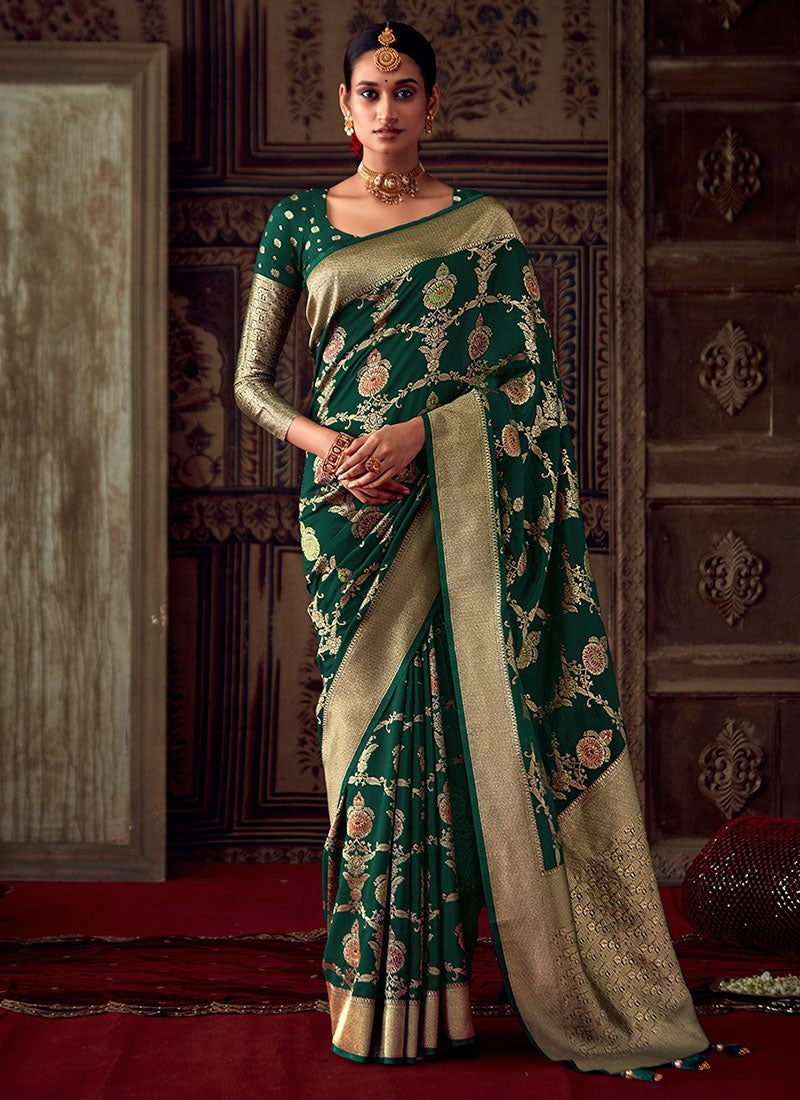The saree is more than just a garment; it is a symbol of cultural identity, tradition, and elegance in India and across South Asia. This timeless attire, often woven with intricate designs and vibrant colors, plays a significant role in various cultural and regional celebrations. From weddings to festivals, the saree embodies the spirit of these occasions, reflecting the rich heritage and diversity of the regions it represents. Let’s delve into the traditions and significance of sarees in cultural celebrations across India.
1. The Timeless Elegance of the Saree
The saree, typically ranging from five to nine yards in length, is known for its versatility. It can be draped in numerous styles, each unique to different regions and communities. This adaptability makes it a preferred choice for various celebrations, allowing women to express their individuality while embracing cultural heritage.
2. Weddings: A Celebration of Love and Tradition
In Indian weddings, the saree is a centerpiece of bridal attire. Each region has its distinctive styles, such as the heavily embroidered Lehenga saree in North India or the traditional Kanjivaram saree in South India.
Bridal Sarees
Brides often wear sarees in auspicious colors like red or gold, symbolizing prosperity and happiness. The saree is adorned with intricate embroidery and embellishments, showcasing the craftsmanship of artisans. The choice of saree can also signify family heritage, with certain styles passed down through generations.
Family Celebrations
During weddings, family members and guests also don sarees, celebrating the occasion with rich fabrics and stunning designs. These sarees often reflect regional craftsmanship, such as Banarasi silk, Chanderi cotton, or Bandhani tie-dye, enhancing the festive atmosphere.
3. Festivals: Celebrating Culture and Spirituality
Festivals across India are vibrant and colorful, and the saree plays a vital role in these celebrations.
Diwali
During Diwali, the festival of lights, women often wear sarees in bright colors to symbolize joy and prosperity. The saree’s intricate designs and embellishments reflect the festive spirit, making it a popular choice for family gatherings and rituals.
Holi
During Holi, the festival of colors, women may opt for lighter sarees that can withstand the splashes of colored powders. The choice of white or pastel shades, often adorned with playful motifs, adds to the festive cheer while allowing for easy cleanup.
Durga Puja and Navratri
In Durga Puja and Navratri, traditional sarees take center stage. Women dress in vibrant sarees with elaborate draping styles, honoring the goddess and participating in rituals and dances. The nine nights of Navratri see women embracing the nine different colors associated with each day, showcasing their connection to tradition and spirituality.
4. Regional Variations: A Tapestry of Diversity
India’s diversity is beautifully reflected in its saree styles, which vary significantly across regions.
North India
In North India, sarees like the Banarasi and the chiffon saree are popular for festive occasions. They are often characterized by intricate motifs and vibrant colors, suitable for celebrations.
South India
South Indian sarees, such as Kanjivarams and Mysore silks, are known for their rich textures and gold borders. These sarees are often worn during temple festivals and family gatherings, symbolizing respect and tradition.
East and West India
In East India, the Paithani and Baluchari sarees reflect the artistic heritage of the region, often worn during cultural festivities. In Western India, the Bandhani and Gharchola sarees are favored, showcasing vibrant colors and traditional tie-dye techniques.
5. Cultural Identity and Expression
The saree serves as a powerful tool for cultural expression. It allows women to connect with their roots, showcasing their heritage and identity during celebrations. Each saree tells a story of its origin, weaving together history, craftsmanship, and regional pride.
6. Contemporary Celebrations and Modern Adaptations
In contemporary society, the saree continues to hold significance, even as styles evolve. Young women are embracing the saree for modern celebrations, often pairing it with contemporary blouses and accessories. This fusion of tradition and modernity keeps the saree relevant, allowing it to adapt to changing fashion sensibilities.
Conclusion
The saree is not just a piece of clothing; it is a symbol of culture, tradition, and identity. Its significance in regional and cultural celebrations highlights the richness of Indian heritage. As generations continue to embrace this timeless attire, the saree remains a beloved garment that unites women in celebration, reflection, and pride in their roots. Whether during weddings, festivals, or everyday life, the saree continues to weave the stories of women across India, celebrating their past while looking towards the future.













